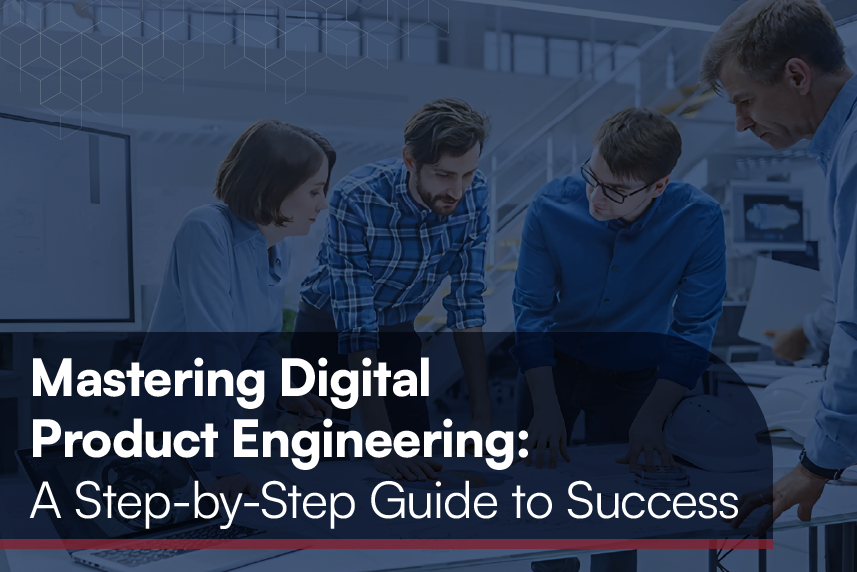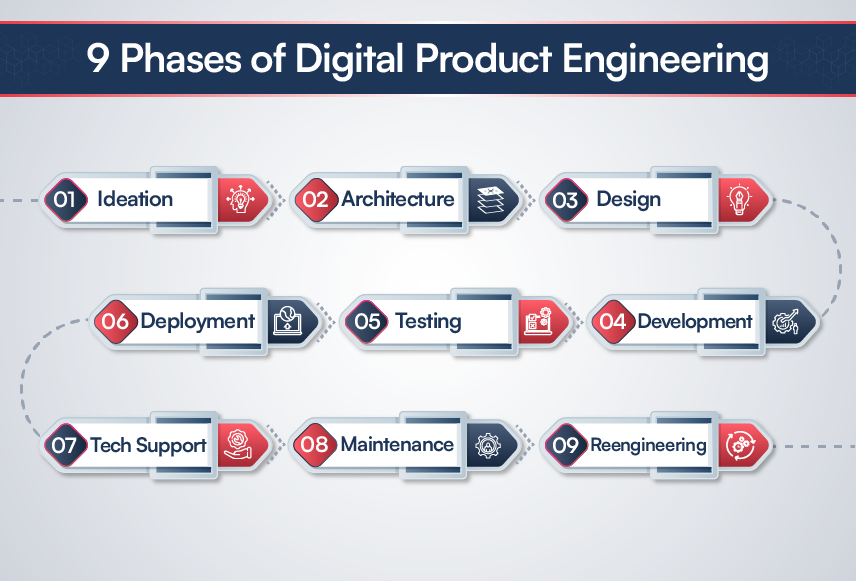
Table of Contents
In today’s rapidly evolving business landscape, digital product engineering plays a pivotal role in helping HR professionals address a myriad of challenges and opportunities. From attracting and retaining top talent to ensuring a seamless employee experience, the HR domain has become increasingly reliant on cutting-edge technology and innovative solutions.
This is where digital product engineering steps in as a transformative force, offering HR teams a powerful toolkit to enhance their operations, streamline processes, and drive organizational success. Organizations specializing in digital product engineering are helping HRTech product companies create value throughout the complete product journey. They achieve this by utilizing advanced technology to craft HR products that resonate with tech-savvy consumers.
According to MarketsandMarkets, the global product engineering services market is projected to reach a value of $1,510 billion by 2027.
The need for continuous innovation, increasing automation and digitization across industries, and high demand for cost efficiency and improved time-to-market are expected to drive the market.
Whether you’re an HRTech expert aiming to build HR products or a business leader eager to leverage HRTech, this guide is your roadmap to unlock the power of digital product engineering within HR. Without delay, let’s delve into the world of digital product engineering, its application in HR, and its potential to accelerate HR and business growth.
What is Digital Product Engineering?
Digital product engineering is a comprehensive process that encompasses the design, development, and maintenance of digital products and services, leveraging cutting-edge technologies and methodologies. This multifaceted approach involves the integration of software engineering, UI/UX design, and other specialized disciplines to create innovative and user-friendly digital solutions.
Digital product engineering in HR helps businesses deliver high-quality, scalable, and market-ready HR products that meet the ever-evolving needs and preferences of employees in today’s rapidly changing digital landscape. The approach involves continuous iteration, agile development practices, and a strong emphasis on user feedback to ensure the end product aligns with business goals.
Harbinger empowered GoCo, a leading HRIS provider, to overcome the obstacle of developing integrations for intricate and advanced use cases. Our solution empowered GoCo to expand its integration offerings from 7 to 100+ and achieve customer acquisition, operational efficiency, and customer retention goals.
9 Phases of Digital Product Engineering

Adherence to a structured cycle is imperative for the development of any product. It helps effectively complete the process from the product’s inception to implementation. Such a process-driven lifecycle empowers product engineers to craft durable digital solutions that cater to customer demands while providing an exceptional user experience.
A standard digital product engineering journey comprises eight stages, from the initial idea to potential reengineering. Let’s dive deeper into each of these stages.
1. Ideation
In this phase, the initial concept of a digital product is conceived. Stakeholders brainstorm ideas, identify market gaps, and define the product’s purpose and features.
2. Architecture
The architecture phase involves planning the technical framework of the product. It includes deciding on technologies, platforms, and system architecture to support the product’s functionality and scalability.
3. Design
User experience and user interface design are developed during the design phase. This step ensures the product is visually appealing, intuitive, and aligned with user needs and preferences.
4. Development
Development is where the actual coding and programming of the product take place. Developers use the chosen technologies and frameworks to build the product’s features and functionality.
5. Testing
Rigorous testing is conducted to identify and rectify bugs, glitches, or usability issues. Quality assurance ensures the product performs reliably and meets user expectations.
6. Deployment
The product is prepared for release once its testing is complete. The deployment phase involves deploying the product to the intended environment and ensuring a smooth transition for users.
7. Technical Support
After the product launch, it is important to provide solid technical support. In this phase, the testing team troubleshoot and resolve product issues to ensure seamless functionality. They gather user feedback to iterate product features and enhance user satisfaction.
8. Maintenance
During maintenance, the major focus is on implementing updates and patches to enhance product stability and security. Proactive maintenance efforts sustain product longevity by addressing bugs, optimizing performance, and adapting to evolving user needs.
9. Reengineering
Over time, as user needs, technologies, and frameworks evolve, the product may require reengineering. This phase involves making substantial changes to the design and development of the product’s features to keep them relevant and competitive.
5 Digital Product Engineering Trends
Familiarizing yourself with the latest digital product engineering trends is essential to keep your digital products competitive and aligned with evolving user expectations. Here are five vital digital product engineering trends that warrant your attention.
1. AI and Machine Learning Integration
The infusion of AI and machine learning into digital product engineering is transforming HR products with predictive analytics, automation, and personalized experiences.
HR departments are leveraging AI and machine learning for talent acquisition and management. These technologies can analyze resumes, predict candidate success, and offer personalized onboarding experiences. For example, AI-driven chatbots can assist new hires with FAQs and provide real-time support, enhancing the employee onboarding process.
2. Internet of Things (IoT)-Driven Solutions
The proliferation of IoT devices is prompting the development of products that seamlessly integrate and leverage data from interconnected devices to enhance functionality and user experiences.
IoT-driven products are changing HR through smart office solutions. For instance, IoT-connected devices can optimize workplace environments based on employee preferences, improving comfort and productivity. Additionally, wearable IoT devices can track employee well-being, helping HR identify and address wellness concerns.
3. Low-Code/No-Code Development
The rise of low-code/no-code platforms enables faster and more accessible product development, allowing a broader range of individuals to contribute to developing digital solutions.
Businesses can use low-code/no-code platforms to build custom HR products without any coding expertise. It enables the rapid creation of tailored HR products and tools, from performance management systems to employee engagement platforms, supporting employee well-being and organizational growth.

4. DevOps and Agile Practices
The adoption of DevOps and agile methodologies continues to streamline development and deployment processes, facilitating quicker iterations and improving team collaboration.
HR teams can use agile principles to develop and implement HR policies, training modules, and performance management processes, ensuring alignment with evolving organizational goals and employee expectations.
5. Virtual Reality (VR) and Augmented Reality (AR)
Integrating VR and AR technologies reshapes digital product engineering by offering immersive and interactive experiences, spanning industries from gaming to training and creating new avenues for innovative product development.
VR and AR can revolutionize HR training and development. Companies can use VR for immersive employee training, creating realistic scenarios for skills enhancement. For example, VR simulations can be used for diversity and inclusion training, helping employees experience different perspectives and improving workplace empathy and understanding.
6 Digital HR Product Engineering Challenges
Understanding digital product engineering challenges is essential if you are to create successful and robust products that keep customers happy. Here are six challenges in digital product engineering for HR.
1. Rapid Technological Evolution in HRTech
HR professionals need to continually adapt to new HR software, tools, and platforms. Continuous learning and collaboration with HRTech experts are crucial to ensure HR solutions remain competitive and capable of meeting evolving workforce needs.
2. Complex Integration of HR Systems
HR departments often rely on multiple systems and platforms, including payroll, benefits administration, talent management, and employee engagement tools. Integrating these systems seamlessly to create a unified HR ecosystem can be challenging.
Digital product engineers need to plan meticulously, anticipate potential integration roadblocks, and establish dedicated testing environments that mirror real-world scenarios while developing HR products. This ensures a smooth flow of data and processes across various HR systems.
A pioneer in AI for enterprise service management approached Harbinger to integrate their chatbot with Workday. We developed a Workato custom connector and recipes, enabling seamless integration, automated workflows, and one-time bulk user synchronization.
3. Data Privacy and Security in HR Products
As HR products handle sensitive employee data, ensuring data privacy and security is a top priority. Compliance with data protection regulations is an ongoing challenge. HRTech experts must embed robust cybersecurity measures into their HR solutions from the outset. Regular security audits and staying informed about evolving regulations are essential to protect employee data and maintain trust among stakeholders.
4. Time-to-Market Pressure for HR Solutions
In the competitive HRTech landscape, getting innovative HR solutions to market quickly is crucial. Balancing speed with quality is a common challenge. HRTech experts must adopt agile methodologies and iterative processes to break down projects into manageable or smaller cycles, prioritize features based on their immediate impact, and avoid shortcuts that might compromise the quality of HR solutions.
5. Talent Shortage in HRTech
Finding skilled HRTech professionals with expertise in the latest technologies and methodologies can be challenging. The demand for HRTech experts often exceeds the available talent pool. Organizations should broaden their recruitment strategies by considering remote workers, freelancers, and external expertise through outsourcing or partnering with HRTech firms to build HR products.
6. Cross-Functional Collaboration in HRTech
Effective collaboration among HRTech product development, testing teams, and other stakeholders is essential for successful HRTech product engineering. Fostering an environment of open dialogue, employing collaborative digital tools, and conducting regular cross-functional meetings ensure alignment among all team members.
Digital Product Engineering for HR and Business Growth
In the realm of HR, digital product engineering serves as a catalyst for innovation, harmonizing technology with the evolving needs of the workforce. Crafting digital HR products that elevate employee experiences and address HR challenges plays a pivotal role in fostering talent retention and organizational advancement.
By utilizing data insights, organizations can refine HR solutions, customize talent management strategies, and make informed choices that boost employee satisfaction, retention, and organizational growth. In HR, combining technology and data-driven decision-making through digital product engineering is a strategic imperative for building a resilient and forward-looking workforce.
Why You Need a Digital HR Product Engineering Partner
In today’s fast-paced business landscape, the role of technology in HR has become indispensable. Engaging a digital HR product engineering partner is a strategic imperative to navigate this transformative terrain effectively. From talent acquisition and management to employee engagement and development, a specialized partner crafts innovative digital products that streamline HR processes.
Collaborating with a digital HR product engineering partner accelerates time-to-market for HRTech solutions. This collaboration can bring proficiency in rapid development cycles and agile methodologies, ensuring hassle-free deployment of products aligned with HR needs.
An experienced digital HR product engineering partner can help organizations gain a competitive edge. The partner can develop advanced HRTech solutions to maximize employee satisfaction, operational efficiency, and business growth.
Getting Started with Digital HR Product Engineering
Embarking on the journey of digital product engineering might seem overwhelming and daunting. However, it presents an exhilarating opportunity to build innovative HR products. The initial phase involves comprehending and appraising your internal HR procedures, technological landscape, and essential shifts needed for transformation.
Next, you need to identify a proficient digital HR product engineering partner who comprehends your vision and possesses the technical prowess to bring ideas to life. Collaborate closely to conceptualize user-friendly designs, ensuring seamless user experiences and breaking down development into manageable iterations. Finally, deploy your digital HR product and gather feedback to fine-tune features and functionalities.
Want to collaborate with a digital HR product engineering partner and build transformative HR solutions? Reach out to our seasoned HRTech specialists.






